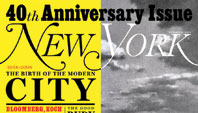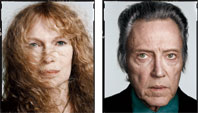
1. Last week’s issue, marking our 40th anniversary (“1968–2008: The Birth of the Modern City,” October 6), was one of the largest in the magazine’s history, so it hit a pretty broad swath of our various constituencies. Our six competing lists of the most influential New Yorkers (“Who Matters Most”) was a natural argument starter, and indeed we got an in-box-ful of heat for various “glaring omissions.” Filmmaker James Toback was particularly incensed: “With all due respect to these august ladies and gentlemen, how can the name of Norman Mailer have been so egregiously omitted? He should have been number one on everybody’s list, as any real New Yorker would know.” Toback added, “And isn’t it high time we resurrected Norman’s mayoral-platform idea of statehood for the city?” Here are some of the other reader nominees: Babe Paley, Spike Lee, the Ramones, Debbie Harry, Ian Schrager, Philippe de Montebello, Vartan Gregorian, Arthur Schlesinger Jr., Thurston Moore, the Beastie Boys, and Keith Haring. Finally, an unorthodox but fully plausible case was made on behalf of “Charles, Eric, Nick the Greek (R.I.P.), and Caroline of Live Bait restaurant and the Coffee Shop Bar, Union Square. These visionaries were defining cool, excellence in service, and quality food at their honky-tonk and Brazilian-themed restaurants at a time when Chock Full o’ Nuts was still considered an acceptable experience.”

2. Among the more divisive features was “The New York Actor,” photographer Dan Winters’s portfolio of the memorable faces of the screen and stage. Winters’s stark, decidedly unglossy style unnerved many readers. “Awful, joyless photos,” was one opinion. “Sylvia Miles was the only person who didn’t look like she was in front of a firing squad.” Another scoffed, “I understand ‘the art’ and ‘the realness’ behind it—all that. But really!” The most succinct criticism: “Just plain mean.” But Winters’s photographs also had plenty of admirers who embraced the chance to see these icons in a fresh light: “These pictures are fabulous. I think they manage to simultaneously show us some integral, beyond-words aspects of these people and to call into question our own concepts of beauty.” The most succinct praise: “Killer work.”
3. There were also a few rebuttals to “Assimilation and Its Discontents,” David Samuels’s essay about the extinction of the New York Jew—“Meh. We didn’t jump the shark, we moved to N.J., Westchester, L.I., and Boca. I can find plenty of old-style kosher delis where I live now”—and many kind remarks about “Yuppies in Eden,” Jay McInerney’s examination of another New York archetype: “What an excellent article. One of the best things that ever happened to me was living in NYC in the eighties. I did not want to be a yuppie, but can’t deny that my career at that time defined me as one. What a wild, crazy, frightening, dirty, pathetic, eye-popping, heartbreaking, life-lesson-learning, beautiful, uplifting roller-coaster ride.” Times food critic Frank Bruni took respectful exception to the Shun Lee Dynasty’s placing fourth on Gael Greene’s list of the fourteen best restaurants of the past four decades (“The Haute-est Cuisine”): “I think it’s a defensible choice, though its rank is certainly too high, given that upscale, serious Chinese hasn’t turned out to be an especially populous, rewarding genre in Manhattan.” And Woody Allen’s assertion that Ivy League kids today aren’t any more sophisticated than your average “churchgoing barbarian” from the Midwest (“In Conversation”) elicited much debate on the blogs. “I don’t know if I have to take this from the guy who wrote What’s Up Pussycat [sic],” wrote a commenter on Gawker, which linked to the interview. “But I agree with him anyway.”
Please send e-mails to: comments@nymag.com